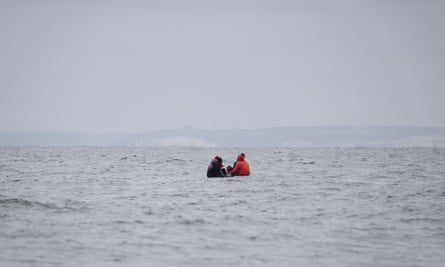Home Office may use nets to stop migrant boats crossing Channel
Nets could be used to clog propellers and halt boats, says former Royal Marine in charge

Migrants on a boat in the Channel in August. The total number of asylum applications received by the UK between April and June nearly halved compared with the first three months of the year. Photograph: Sameer Al-Doumy/AFP/Getty Images
Jamie Grierson Home affairs correspondent Sun 11 Oct 2020 THE GUARDIAN
The Home Office is considering permitting the use of nets to prevent migrants from crossing the Channel in small boats to the UK to claim asylum, according to a former Royal Marine tasked with preventing the journeys.
In an interview with the Daily Telegraph, the Home Office’s clandestine channel threat commander, Dan O’Mahoney, said nets could be used to clog propellers and bring boats to a standstill as they attempt the crossing over the Dover Strait.
O’Mahoney told the Telegraph: “It’s that type of thing, yes. So, safely disabling the engine and then taking the migrants onboard our vessel.”
The tactic is the latest tactic reported to be under consideration by ministers and officials alongside locking migrants up on oilrigs, sending them more than 5,000 miles away to Ascension Island in the south Atlantic and using water cannon to create waves to push back vessels.
While the number of people arriving in the UK in small boats has increased nearly four-fold this year to more than 7,000, the total number of asylum applications received by the UK government between April and June nearly halved compared with the first three months of the year as the Covid-19 pandemic struck.
O’Mahoney told the Telegraph nets were one of a number of methods “which we may deploy over the next few months. But given that we’re not using them yet I’m not at liberty to go into detail about them … We are working with maritime security departments across law enforcement and military, everywhere across government [to] come up with new tactics to tackle this problem”.
He added: “We definitely are very, very close to being able to operationalise a safe return tactic where we make an intervention safely on a migrant vessel, take migrants onboard our vessel and then take them back to France.”
O’Mahoney used the interview to unveil a four-stage plan to tackle the issue of undocumented migration: using social media to attempt to stop the flow of migrants from Africa and the Middle East into northern France, reducing the number of asylum seekers leaving the region for the UK, physically preventing entry to the UK and reforming Britain’s asylum system.
The final strand was touched upon by the home secretary, Priti Patel, in her speech to the virtual Conservative party conference last week. She called the asylum system “fundamentally broken” and promised new laws to deny asylum to those using unofficial routes to enter the UK.
Speaking at the Conservative party conference, the home secretary said she would bring in legislation next year to stop “endless legal claims” from refused asylum seekers and was willing to face “being unpopular on Twitter” in order to bring down the number of claims.
Jamie Grierson Home affairs correspondent Sun 11 Oct 2020 THE GUARDIAN
The Home Office is considering permitting the use of nets to prevent migrants from crossing the Channel in small boats to the UK to claim asylum, according to a former Royal Marine tasked with preventing the journeys.
In an interview with the Daily Telegraph, the Home Office’s clandestine channel threat commander, Dan O’Mahoney, said nets could be used to clog propellers and bring boats to a standstill as they attempt the crossing over the Dover Strait.
O’Mahoney told the Telegraph: “It’s that type of thing, yes. So, safely disabling the engine and then taking the migrants onboard our vessel.”
The tactic is the latest tactic reported to be under consideration by ministers and officials alongside locking migrants up on oilrigs, sending them more than 5,000 miles away to Ascension Island in the south Atlantic and using water cannon to create waves to push back vessels.
While the number of people arriving in the UK in small boats has increased nearly four-fold this year to more than 7,000, the total number of asylum applications received by the UK government between April and June nearly halved compared with the first three months of the year as the Covid-19 pandemic struck.
O’Mahoney told the Telegraph nets were one of a number of methods “which we may deploy over the next few months. But given that we’re not using them yet I’m not at liberty to go into detail about them … We are working with maritime security departments across law enforcement and military, everywhere across government [to] come up with new tactics to tackle this problem”.
He added: “We definitely are very, very close to being able to operationalise a safe return tactic where we make an intervention safely on a migrant vessel, take migrants onboard our vessel and then take them back to France.”
O’Mahoney used the interview to unveil a four-stage plan to tackle the issue of undocumented migration: using social media to attempt to stop the flow of migrants from Africa and the Middle East into northern France, reducing the number of asylum seekers leaving the region for the UK, physically preventing entry to the UK and reforming Britain’s asylum system.
The final strand was touched upon by the home secretary, Priti Patel, in her speech to the virtual Conservative party conference last week. She called the asylum system “fundamentally broken” and promised new laws to deny asylum to those using unofficial routes to enter the UK.
Speaking at the Conservative party conference, the home secretary said she would bring in legislation next year to stop “endless legal claims” from refused asylum seekers and was willing to face “being unpopular on Twitter” in order to bring down the number of claims.
No comments:
Post a Comment